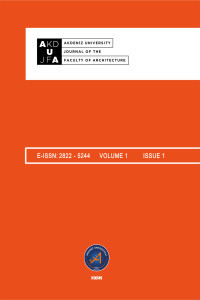KONUT VE ÇEVRESİNDE BIYOFİLİK TASARIM YAKLAŞIMI: ANKARA ÖRNEĞİ
biyofilik tasarım, biyofilik şehircilik, sürdürülebilir kent, Ankara, Beytepe
Biophilic Design Approach to Housing and Its Environment: The Case of Ankara
biyofilik tasarım, biyofilik şehircilik, sürdürülebilir kent, Ankara, Beytepe,
___
- Abdollahi, S., Oktay, H., 2020. Çevre Estetiğinde Kullanılan Modellerin Değerlendirilmesi ve Biyofilya Bağlamında Yeni Bir Model Önerisi. Yedi, (23), 75-86.
- Beatley, T., & Wilson, E. O. (2011). Biophilic cities: Integrating nature into urban design and planning. Island Press.
- Çorakçı, R. E. 2016. İç mimarlıkta biyofilik tasarım ilkelerinin belirlenmesi [Doktora Tezi]. Mimar Sinan Güzel Sanatlar Üniversitesi Fen Bilimleri Enstitüsü. İstanbul.
- Erbay, M. 2018. İç Mekânda Güncel Bir Söylem: “Biyofilik Tasarım” ve Uygulama Örneği Olarak Memorial Bahçelievler Hastanesi, 2. Ulusal İç Mimari Tasarım Sempozyumu, KTÜ İç Mimarlık Bölümü, Trabzon, Tasarıma Dair Güncel Söylemler, 23–31
- Erwin, E.A., Custis, N., Ronmark, E. 2005. Asthma and indoor air: contrasts in the dose response to cat and dust-mite. Indoor air. 15(10), 33-39.
- Fromm, E. 1964. The heart of man. Harper & Row Publishers. New York.
- Gökten, İ., Kelkit, A., 2021. Ankara İmrahor Vadisi ve İncesu Deresinin biyofilik tasarım yaklaşımı içinde değerlendirilmesi. ÇOMÜ Ziraat Fakültesi Dergisi, 9(1), 71-78.
- Gür, M., Kaprol, M., 2021. The Participation of Biophilic Design in the Design of the Post-Pandemic Living Space (Eds.), Emerging Approaches in Design and New Connections with Nature, Pennsylvania, IGI Global, pp.75-106. DOI: 10.4018/978-1-7998-6725-8.ch004
- İrfanoğlu, H. İ., Suri, L., 2022. Biyofilik Tasarım Kriterlerinin Mekanlar Üzerinden Değerlendirilmesi. İstanbul Ticaret Üniversitesi Fen Bilimleri Dergisi, 21(41), 95-116.
- Kellert, S. R., 2008. Dimensions, Elements, Attributes of Biophilic Design. In Kellert, Heerwagen & Mador (Eds.), Biophilic Design. Hoboken, NJ: Wiley, pp 3–19
- Kellert, S., Calabrese, E., 2015. The Practice of Biophilic Design. Retrived April 11, 2021 from www.biophilic-design.com
- Kellert, S. R., Heerwagen, J., Mador, M., 2011. Biophilic design: the theory, science and practice of bringing buildings to life. John Wiley & Sons.
- Pollack, M. H. 2006. Telomere shortening and mood disorders: preliminary support for a chronic stress model of accelerated aging. Biological Psychiatry, 60(5), 432-435.
- Rast Group, 2019. “AvendBeytepe”. https:// www.avendbeytepe.com/wpcontent/uploads /2019/03/AVEND _Beytepe_Katalog_Web.pdf / (Erişim 20.08.2022)
- Ryan, C. O., Browning, W. D., Clancy, J. O., 2014. 14 Patterns of Biophilic Design; Improving Health & Well-Being in the Built Environment. Retrieved April 10, 2021 from https://www.terrapinbrightgreen.com/publications/
- Russo, A., Cirella, G. T., 2017. Biophilic Cities: planning for sustainable and smart urban environments (Eds.), Global Policy and Observer Research Foundation, London, pp. 153-159. ISBN 9788186818299
- Soderlund, J., Newman, P., 2015. Biophilic architecture: A review of the rationale and outcomes. AIMS Environmental Science, 2(4):950-969. https://doi.org/10.3934/environsci.2015.4.950.
- Heerwagen, J. H., and Orians, G. H. 1993. Humans, habitats, and aesthetics. In S. R. Kellert and E. O. Wilson, (Eds.). The biophilia hypothesis (pp. 138-172). Washington DC: Island Press.
- Yayın Aralığı: Yılda 2 Sayı
- Başlangıç: 2022
- Yayıncı: Akdeniz Üniversitesi
GELENEKSEL KORE EVİ HANOK’UN FENG SHUI İLKELERİ İLE KUTSAL MEKANA DÖNÜŞÜMÜ
Ayşan Ilgın POLAT, Sıdıka Benan ÇELİKEL
SİMGESEL VE ANLAMSAL YAKLAŞIMLAR ÜZERİNE BİR UYGULAMA DENEYİMİ: Hz. EBUBEKİR CAMİ ÖRNEĞİ
KONUT VE ÇEVRESİNDE BIYOFİLİK TASARIM YAKLAŞIMI: ANKARA ÖRNEĞİ
Mezarlık Ekosistemlerinin Kentsel Isı Adaları Üzerindeki Etkileri
